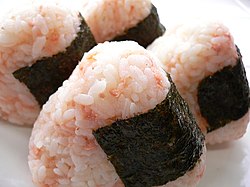お握り
Jump to navigation
Jump to search
Japanese
[edit]| Kanji in this term |
|---|
| 握 |
| にぎ(り) Grade: S |
| kun'yomi |
| Alternative spellings |
|---|
| 御握り 御握 |

Etymology
[edit]Compound of お (o-, honorific prefix) + 握り (nigiri, “grasp, grip, handful”), the 連用形 (ren'yōkei, “stem form”) of verb 握る (nigiru, “to grasp, to grip, to squeeze in one's hand”).[1][2]
Pronunciation
[edit]Noun
[edit]- (childish) a closing or grasping of one's hand
- a rice ball (from the way the ball is formed by squeezing a handful of rice in one's hands)
- Synonyms: お結び (omusubi), 握り飯 (nigiri meshi)
- Vaguely similar to a sandwich in concept, but smaller and less filling. Typically has something in the center, or mixed into the rice, such as an 梅干し (umeboshi, “pickled plum”), tuna salad, salmon, chicken teriyaki, or some other savory ingredient. Often wrapped in 海苔 (nori, “a sheet of roasted seaweed”), either entirely, or with a strip. Traditionally triangular.
References
[edit]- ^ Shōgaku Tosho (1988) 国語大辞典(新装版) [Unabridged Dictionary of Japanese (Revised Edition)] (in Japanese), Tōkyō: Shogakukan, →ISBN
- ↑ 2.0 2.1 Matsumura, Akira, editor (2006), 大辞林 [Daijirin] (in Japanese), Third edition, Tokyo: Sanseidō, →ISBN
- ^ NHK Broadcasting Culture Research Institute, editor (1998), NHK日本語発音アクセント辞典 [NHK Japanese Pronunciation Accent Dictionary] (in Japanese), Tokyo: NHK Publishing, Inc., →ISBN

